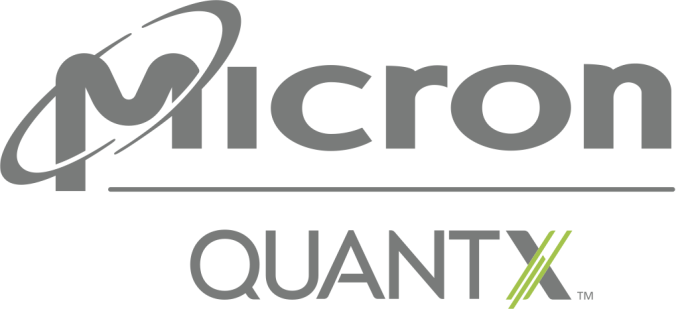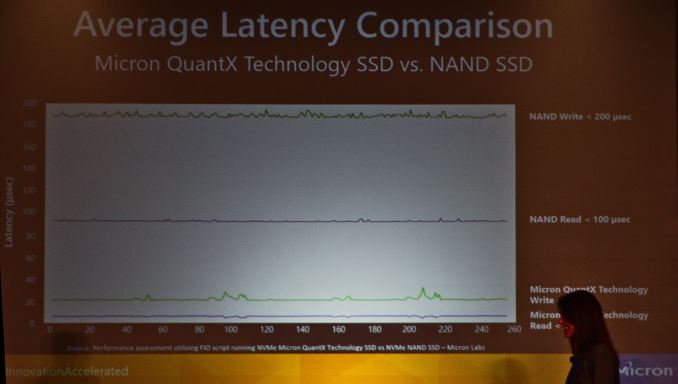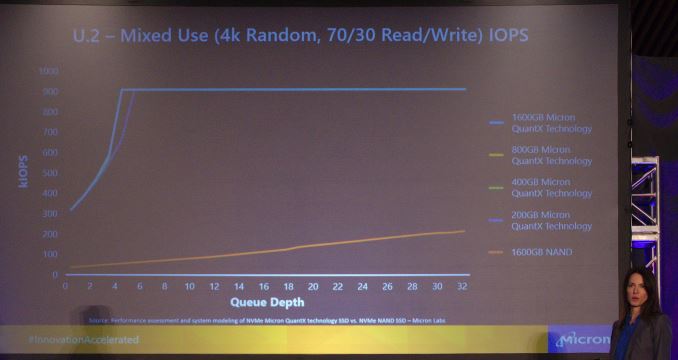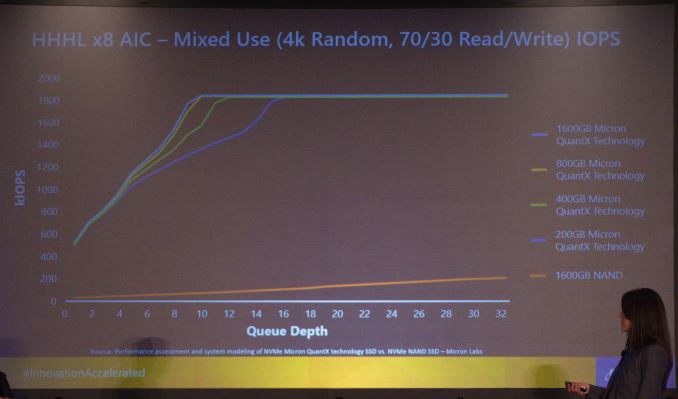Micron Announces QuantX Branding For 3D XPoint Memory (UPDATED)
by Billy Tallis on August 9, 2016 10:45 AM EST- Posted in
- SSDs
- Micron
- 3D XPoint
- Flash Memory Summit
- QuantX

In a keynote speech later this morning at Flash Memory Summit, Micron will be unveiling the branding and logo that their products based on 3D XPoint memory will be using. The new QuantX brand is Micron's counterpart to Intel's Optane brand and will be used for the NVMe storage products that we will hear more about later this year. 3D Xpoint memory was jointly announced by Intel and Micron shortly before last year's Flash Memory Summit and we analyzed the details that were available at the time. Since then there has been very little new official information but much speculation. We do know that the initial products will be NVMe SSDs rather than NVDIMMs or other memory bus attached devices.
In the meantime, Micron VP Darren Thomas goes on stage at 11:30 AM PT, and we'll update with any further information.
UPDATE:
Micron's keynote reiterated their strategy of positioning 3D XPoint and thus QuantX products in between NAND flash and DRAM, with the advantages of 3d XPoint relative to each highlighted (while the disadvantages go unmentioned). But then they moved on to showing some meaningful performance graphs from actual benchmarks of QuantX drives.
The factor of ten improvement in both read and write latency for NVMe drives is great, but perhaps the more impressive results are the graphs showing queue depth scaling. In a comparison of U.2 NVMe drives, Micron showed performance of QuantX drives ranging from 200GB to 1600GB, relative to a 1600GB NAND flash NVMe SSD. The QuantX drives saturated the PCIe x4 link with a 70/30 mix of random reads and random writes with queue depths of just 4-6, while the NAND SSD gets nowhere close to saturating the link with random accesses. The next comparison was of the PCIe x8 add-in card performance, where the link was saturated with queue depths between 10 and 16, depending on the capacity of the QuantX drive.
This great performance at low queue depths will make it relatively easy for a wide variety of workloads to benefit from the raw performance 3D XPoint memory offers. By contrast, the biggest and fastest PCIe SSDs based on NAND flash often require careful planning on the software side to achieve full utilization.
Source: Micron



















52 Comments
View All Comments
beginner99 - Wednesday, August 10, 2016 - link
My guess is DIMMs are delayed because endurance is an issue. You would need trillions of cycles to make it usable as RAM or even more. It's just not comparable to what NAND flash currently does.Kevin G - Wednesday, August 10, 2016 - link
The DIMM form factor needs host memory controller support. The first chip scheduled to include that is SkyLake-EP which is set to arrive sometime next year.TheWrongChristian - Wednesday, August 10, 2016 - link
So, as the cache memory in the SSD controller, replacing the existing DRAM cache used in existing designs? It can also replace the pseudo-SLC used in the NAND as well. Something like 32GB of Xpoint cache in a 1TB SSD will provide useful latency benefits for cached data, and buffer writes to improve performance and preserve erase cycles much as the pseudo-SLC does now, only better.Hell, stick that 32GB Xpoint cache in a hybrid SMR HDD. The cache could all but hide the shingling overhead for most common usage patterns.
emn13 - Wednesday, August 10, 2016 - link
At some point, intel/micron claimed DRAM-like performance. However, based on their *own* slides here, it's around 1000 (!) times slower (in terms of latency) - not quite that slow for reads, much slower for writes.limitedaccess - Wednesday, August 10, 2016 - link
It was presented as slower than DRAM originally.NVMe may also be a bottleneck in this case as well.
Flunk - Tuesday, August 9, 2016 - link
I don't think we're going to see consumer products based on this tech for a while.frenchy_2001 - Tuesday, August 9, 2016 - link
Indeed. The cost and availability for the first few years will be reserved for higher margin enterprise products. One good way to recoup development costs.zodiacfml - Tuesday, August 9, 2016 - link
Even if it is available at twice consumer SSD prices, the advantages will not be noticeable in real world use.This is for enterprises or businesses with very particular needs.
beginner99 - Wednesday, August 10, 2016 - link
I'm not so sure. The biggest advanatge of SSD vs hdd isn't bandwidth/max speed but latency. Even my old Intel G2 made a huge difference and at 80 GB it actually had slower max write speed than most HDDs of that time but that wasn't noticeable at all.hansmuff - Wednesday, August 10, 2016 - link
Agreed. Now, for HDDs we had what, ~20ms service times (seek plus latency). NAND SSDs about 100us (microsec) for reads, according to the slides. so it's about a factor of 200 between those technologies. Like you said, even an old SSD makes a huge difference where the factor may only be 100-150.But that's coming from milliseconds*thousands of files for booting Windows for instance. We're in the microseconds*thousands now and we can already see that newer, much faster SSDs compared to first gen don't make as much of a difference as one would like to believe. Games load maybe a second or three faster. Some niches like Windows hibernation can really benefit from the higher transfer speeds. But it's kind of "meh".
Databases will certainly love it, much higher IOPS and lower latency is what they live for, but the performance gain in client space I think is going to be somewhat muted.